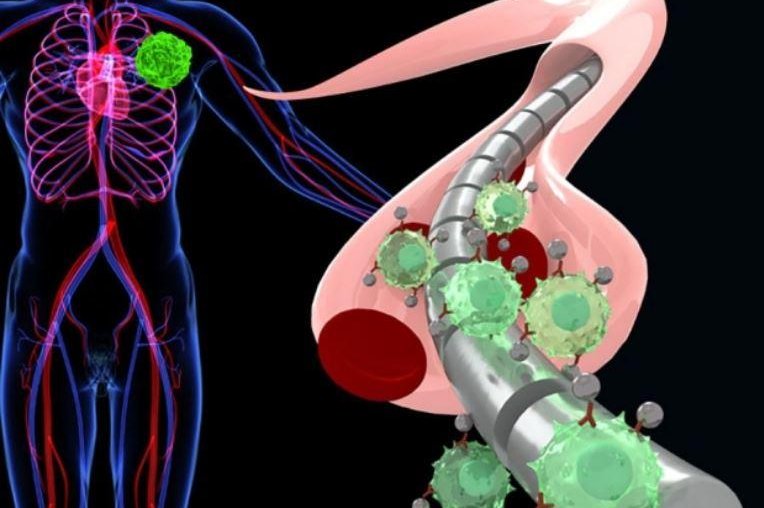If approved for use in humans, the magnetic wire (gray) would be inserted into a vein in the arm (light pink) and attract floating cancer cells labeled with magnetic nanoparticles (light green and gray) from the tumor (neon green). Image courtesy of
Sam Gambhir/Stanford
July 16 (UPI) -- Researchers have developed a magnetic wire as a quick and effective way to detect cancer early, according to a recent study with pigs.
The researchers report that the wire could be more effective than standard methods to catch hard-to-find cancer cells in the blood stream.
"We estimate that it would take about 80 tubes of blood to match what the wire is able to sample in 20 minutes," Dr. Sam Gambhir, chairman of radiology and director of the Canary Center at Stanford for Cancer Early Detection, said in a press release.
The research was published Monday in Nature Biomedical Engineering.
The wire is inserted through a standard intravenous catheter and attracts special magnetic nanoparticles engineered to attach onto tumor cells roaming the bloodstream, and uses them as an indication of a tumor somewhere in the body. By magnetizing the tumor cells, the researchers say the wire can lure the cells out of the bloodstream.
The technique attracts from 10 to 80 times more tumor cells than in a 5 milliliter blood draw, and 500 to 5,000 times using the commercially available wire-based detection method, Gilupi CellCollector.
Gambhir said doctors, based on the information, could evaluate a patient's response to particular cancer treatments.
And it can be used for other diseases, he said.
"It could be useful in any other disease in which there are cells or molecules of interest in the blood," Gambhir said. "For example, let's say you're checking for a bacterial infection, circulating tumor DNA or rare cells that are responsible for inflammation in any of these scenarios, the wire and nanoparticles help to enrich the signal, and therefore detect the disease or infection."
Cells can serve as cancer biomarkers for the disease, but these circulating tumor cells are often scarce. With only a few milliliters of the total blood volume from the total body, the amount of tumors detected would be minuscule.
"These circulating tumor cells are so few that if you just take a regular blood sample, those test tubes likely won't even have a single circulating tumor cell in them," Gambhir said. "So doctors end up saying, 'Okay, nothing's there.'"
The researchers are awaiting approval from the U.S. Food and Drug Administration for testing in humans.
In the meantime, the researchers are conducting toxicity ttests in mice, studying what happens to leftover nanoparticles that don't bind. So far, the researchers have found no signs of toxicity, and nanoparticles left over in decay over a few weeks.
Gambhir said the technique could also be used in places that are hard to find in a biopsy or to provide information about the efficacy of a cancer treatments.
"So, we're hoping this approach will enrich our detection capability and give us better insight into just how rare these circulating tumor cells are, and how early on they exist once the cancer is present," Gambhir said.















